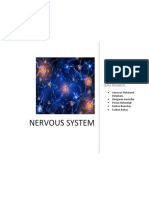sg
sg
Uploaded by
miuccia091130Copyright:
Available Formats
sg
sg
Uploaded by
miuccia091130Copyright
Available Formats
Share this document
Did you find this document useful?
Is this content inappropriate?
Copyright:
Available Formats
sg
sg
Uploaded by
miuccia091130Copyright:
Available Formats
Miu 93
Study Guide: Neural Signal Processing
1. Neurons and Electrical Signals
Neurons are the basic functional units of the nervous system, transmitting information
using electrical impulses called action potentials.
Action potentials are generated when the membrane potential of a neuron changes
due to the movement of ions (primarily sodium (Na⁺) and potassium (K⁺)) across the
membrane.
Resting potential: The neuron maintains a resting membrane potential, typically
around -70 mV, which is the result of the distribution of ions across the neuronal
membrane.
Depolarization: Occurs when the neuron's membrane potential becomes less
negative (closer to 0), usually due to the influx of Na⁺ ions. Once a certain threshold
is reached (around -55 mV), an action potential is triggered.
Repolarization: After reaching the peak of the action potential, the membrane
potential returns toward the resting state, primarily through the efflux of K⁺ ions.
Hyperpolarization: A brief phase where the membrane potential becomes more
negative than the resting potential.
All-or-none law: An action potential either occurs fully or not at all once the
threshold potential is reached. The strength of the action potential remains
constant, regardless of the intensity of the stimulus.
2. Synaptic Transmission
Neurons communicate with each other across synapses, which can be electrical (direct
ion flow between neurons via gap junctions) or chemical (involving neurotransmitter
release).
Chemical synapses:
Presynaptic neuron releases neurotransmitters stored in vesicles into the synaptic
cleft in response to an action potential.
The neurotransmitters bind to specific receptors on the postsynaptic neuron,
leading to ion channel opening and changes in the postsynaptic membrane
Printed with ChatGPT to PDF 1/3
potential, which can either excite or inhibit the postsynaptic neuron.
Excitatory postsynaptic potential (EPSP): Makes the postsynaptic neuron more
likely to fire an action potential (depolarization).
Inhibitory postsynaptic potential (IPSP): Makes the postsynaptic neuron less likely
to fire (hyperpolarization).
Key neurotransmitters include:
Glutamate (excitatory)
GABA (inhibitory)
Dopamine, serotonin, acetylcholine, and norepinephrine (modulatory).
3. Neurotransmitter Release Mechanism
The action potential causes voltage-gated calcium (Ca²⁺) channels to open in the
presynaptic terminal.
The influx of Ca²⁺ triggers the fusion of neurotransmitter-containing vesicles with the
presynaptic membrane, allowing neurotransmitter release into the synaptic cleft.
Neurotransmitter reuptake or degradation terminates the signal, ensuring that the
postsynaptic neuron is not continuously stimulated.
4. Synaptic Plasticity
Synaptic plasticity refers to the ability of synapses to strengthen or weaken over time, in
response to increases or decreases in activity. It's essential for learning and memory.
Long-term potentiation (LTP): Strengthens the synapse, making the postsynaptic
neuron more responsive to inputs.
Long-term depression (LTD): Weakens the synapse, reducing the responsiveness of
the postsynaptic neuron.
Plasticity is modulated by various factors, including neurotransmitter release, receptor
density, and calcium signaling.
5. Ion Channels and Neurophysiology
Voltage-gated ion channels: Open in response to changes in membrane potential and
are critical for generating action potentials.
Sodium (Na⁺) channels: Rapidly open to initiate depolarization.
Potassium (K⁺) channels: Open to repolarize the cell after depolarization.
Printed with ChatGPT to PDF 2/3
Calcium (Ca²⁺) channels: Play a role in neurotransmitter release.
Ligand-gated ion channels: Open in response to the binding of a neurotransmitter
(ligand), allowing specific ions to flow through and change the postsynaptic membrane
potential.
6. Neural Circuits and Signal Integration
Neural circuits are networks of neurons that process specific types of information.
Neurons integrate multiple inputs from different sources:
Spatial summation: The process by which the postsynaptic neuron integrates input
from different synapses at the same time.
Temporal summation: Integration of signals that arrive at the synapse in rapid
succession.
Feedforward and feedback inhibition are mechanisms that help regulate neural circuits
and maintain balance in neural activity.
7. Electrophysiology Tools in Neural Signal Processing
Electroencephalography (EEG): Measures electrical activity of the brain and is used to
study neural oscillations and brain states (e.g., sleep cycles).
Patch-clamp recording: Measures ion channel activity in neurons.
Functional MRI (fMRI): Indirectly measures neural activity by detecting changes in blood
flow, providing insights into brain regions involved in specific tasks.
8. Disorders of Neural Signal Processing
Epilepsy: Characterized by abnormal, excessive neuronal firing.
Multiple sclerosis: Involves the degradation of myelin sheaths, disrupting the
propagation of action potentials.
Parkinson’s disease: Results from the degeneration of dopaminergic neurons, affecting
motor control.
This detailed guide covers the key components of Neural Signal Processing and can be
adapted based on further needs. Let me know if you want specific details expanded!
Printed with ChatGPT to PDF 3/3
You might also like
- Get Biological Science 7th Edition (Ebook PDF) Free All ChaptersDocument43 pagesGet Biological Science 7th Edition (Ebook PDF) Free All Chaptershayansljusa50% (8)
- ISSA Strength and Conditioning Performance Psychology Main Course TextbookDocument586 pagesISSA Strength and Conditioning Performance Psychology Main Course TextbookMadiha Saleem100% (11)
- An Introduction To Behavioral EndocrinologyDocument37 pagesAn Introduction To Behavioral EndocrinologykitsuneNo ratings yet
- EBB 2020 Phase 1 TestDocument9 pagesEBB 2020 Phase 1 TestMohamed Hamed Issa100% (1)
- Neuroscience: Science of The Brain in FrenchDocument72 pagesNeuroscience: Science of The Brain in FrenchInternational Brain Research OrganizationNo ratings yet
- Kumpulan Quiz CourseraDocument13 pagesKumpulan Quiz CourseraNadya Azzahra Salsabilla SaragihNo ratings yet
- Physiology. Hrd.Document549 pagesPhysiology. Hrd.Sʌɩĸʌt PʌʋɭNo ratings yet
- Pocket - Companion - To - Guyton - and - Hall - Textbook - of - Medical - Physiology - ExportedDocument7 pagesPocket - Companion - To - Guyton - and - Hall - Textbook - of - Medical - Physiology - Exportedhassnfiras04No ratings yet
- 6 Introduction To The Pharmacology of CNS DrugsDocument34 pages6 Introduction To The Pharmacology of CNS Drugsjjjiii394No ratings yet
- KXFVHKSZJFVNDocument2 pagesKXFVHKSZJFVNxinyi.huang3No ratings yet
- Lecture 2 Neuron and synapDocument54 pagesLecture 2 Neuron and synapminhph.23bi14469No ratings yet
- Biology AssDocument5 pagesBiology Asshafsakhanukl34No ratings yet
- Excitable Tissues and Action PotentialDocument5 pagesExcitable Tissues and Action PotentialAbdulkadir Yaxye OsmanNo ratings yet
- Part-1-NT-Abeer-Document28 pagesPart-1-NT-Abeer-brokeny15No ratings yet
- ZOOLOGY BookDocument115 pagesZOOLOGY BookboymeharboyNo ratings yet
- SynapseDocument12 pagesSynapseSweety DhillonNo ratings yet
- Technical DescriptionDocument8 pagesTechnical Descriptioncool_comic88100% (1)
- Chapter 3 and 4 - Muscles and NerveDocument19 pagesChapter 3 and 4 - Muscles and Nervetahira UroojNo ratings yet
- C-5 Signal TyransmissionDocument14 pagesC-5 Signal TyransmissionSwad Abdul khalikNo ratings yet
- Introduction To CNS: Montoya, Irene Jane M. MS PharmacyDocument28 pagesIntroduction To CNS: Montoya, Irene Jane M. MS PharmacyYan MontoyaNo ratings yet
- Synapse and Muscle Physiology: Lecturer - I. Savinkova, PHD Department of PhysiologyDocument50 pagesSynapse and Muscle Physiology: Lecturer - I. Savinkova, PHD Department of PhysiologyИринаNo ratings yet
- Quiz IDocument34 pagesQuiz Igmkydk7vyxNo ratings yet
- 5 SynapsesDocument60 pages5 Synapsesrosario gonzalezNo ratings yet
- Tutoria 1 - A Força Que Faltava: Neuroanatomia BásicaDocument16 pagesTutoria 1 - A Força Que Faltava: Neuroanatomia BásicaMaria Eduarda VianaNo ratings yet
- Action Potential Generation in Cardiac MuscleDocument10 pagesAction Potential Generation in Cardiac MuscleAhmad HaNo ratings yet
- SynapseDocument7 pagesSynapseSinan Sa100% (1)
- Week5 3 Neurophysiology Part2 2023Document43 pagesWeek5 3 Neurophysiology Part2 2023yanikashahNo ratings yet
- Action PotentialDocument3 pagesAction PotentialGilPeñaflorNo ratings yet
- 29.1.11 Lecture 7. Synapses, Properties & TransmissionDocument37 pages29.1.11 Lecture 7. Synapses, Properties & TransmissionAttiqaQureshiNo ratings yet
- Lecture 2Document6 pagesLecture 2Vivek ChaudharyNo ratings yet
- 111 Week 2 WorksheetDocument4 pages111 Week 2 WorksheetjabyleynesNo ratings yet
- 211 16-23Document42 pages211 16-23wonderfulmonica06No ratings yet
- Bio Notes SynapseDocument4 pagesBio Notes SynapseLeeroy MafuruseNo ratings yet
- SynapsesDocument6 pagesSynapsesJeff ParkNo ratings yet
- Psikofarmakoloji Ders Notları 1Document13 pagesPsikofarmakoloji Ders Notları 1libreizanNo ratings yet
- Synaptic Transmission 4Document36 pagesSynaptic Transmission 4stehephNo ratings yet
- BLOC 2 PSICOBIO (Find Seratonin)Document27 pagesBLOC 2 PSICOBIO (Find Seratonin)cporcuna26No ratings yet
- Biokimia SarafDocument41 pagesBiokimia SarafSang Aji Samudra AnugrahNo ratings yet
- Synaptic TransmissionDocument17 pagesSynaptic Transmissionyanaasv05No ratings yet
- Structures and Processes of The Nervous SystemDocument20 pagesStructures and Processes of The Nervous SystemAna G. VelascoNo ratings yet
- Topic - NeuronsDocument61 pagesTopic - Neuronsyoshitasingh77No ratings yet
- Intro Animal Physiology Ch-2.1Document97 pagesIntro Animal Physiology Ch-2.1Jojo MendozaNo ratings yet
- Tutorial 4.3Document5 pagesTutorial 4.3Rosa FinizioNo ratings yet
- Unit 1 BiopsychologyDocument51 pagesUnit 1 BiopsychologyWriternal CommunityNo ratings yet
- ModelSystem Synapse NeurotransmittersDocument41 pagesModelSystem Synapse NeurotransmittersTapan Kumar PalNo ratings yet
- Neuronal CommunicationDocument29 pagesNeuronal CommunicationSamantha CNo ratings yet
- Module 2.1 The Concept of The SynapseDocument4 pagesModule 2.1 The Concept of The SynapseArcanus LorreynNo ratings yet
- General Physiology of SynapsesDocument30 pagesGeneral Physiology of SynapsesSanchezNo ratings yet
- BIO 201 Chapter 12, Part 1 LectureDocument35 pagesBIO 201 Chapter 12, Part 1 LectureDrPearcyNo ratings yet
- CNS PharmacologyDocument22 pagesCNS Pharmacologyahmed mahamedNo ratings yet
- Synapses .... DR Mazhar 03066980980Document14 pagesSynapses .... DR Mazhar 03066980980Sana AslamNo ratings yet
- Synapses and Synaptic Transmission: Dr. Eman El Eter Physiology Dep. College of Medicine KSUDocument43 pagesSynapses and Synaptic Transmission: Dr. Eman El Eter Physiology Dep. College of Medicine KSUraanja2No ratings yet
- Nervous System: Team MembersDocument8 pagesNervous System: Team MembersnehaNo ratings yet
- Principles of NeurotransmissionDocument2 pagesPrinciples of NeurotransmissionSurabhi AgarwalNo ratings yet
- Intro of Epilepsy - 1. Basic MechanismDocument26 pagesIntro of Epilepsy - 1. Basic MechanismMichael DrakeNo ratings yet
- Nervous System PowerpointDocument39 pagesNervous System PowerpointManveer SidhuNo ratings yet
- Lecture 8ADocument17 pagesLecture 8AAbdullah EwaisNo ratings yet
- CAPE Nervous Coordination NotesDocument24 pagesCAPE Nervous Coordination NotesSharina GeraldNo ratings yet
- 003 Biokimia SarafDocument86 pages003 Biokimia Sarafbonne_ameNo ratings yet
- Sensory - Chap1Document74 pagesSensory - Chap1Ahmed khanNo ratings yet
- KIN 270 Unit 2 Neural Physiology Part 4Document4 pagesKIN 270 Unit 2 Neural Physiology Part 4Armando AlehandroNo ratings yet
- PSYC 223 Lecture 3Document71 pagesPSYC 223 Lecture 3Bernard AnaneNo ratings yet
- Somatosensory Teachers Manual: for Somatosensory Science FactsFrom EverandSomatosensory Teachers Manual: for Somatosensory Science FactsNo ratings yet
- Chasing Men on Fire: The Story of the Search for a Pain GeneFrom EverandChasing Men on Fire: The Story of the Search for a Pain GeneNo ratings yet
- Why Hitler Launched Operation BarbarossaDocument11 pagesWhy Hitler Launched Operation Barbarossamiuccia091130No ratings yet
- Chemistry: The Study of Matter and Its ChangesDocument12 pagesChemistry: The Study of Matter and Its Changesmiuccia091130100% (1)
- 20 APWH Unit 4 SAQs PDFDocument5 pages20 APWH Unit 4 SAQs PDFmiuccia091130No ratings yet
- Cell Growth and DivisionDocument25 pagesCell Growth and Divisionmiuccia091130No ratings yet
- AlgII SG 13 (0-84)Document8 pagesAlgII SG 13 (0-84)miuccia091130No ratings yet
- Nervous TissueDocument12 pagesNervous Tissuesainakaka06No ratings yet
- Background - Action PotentialsDocument5 pagesBackground - Action PotentialsGalex Yeve0% (1)
- Chapter 6 The Peripheral Nervous System, Afferent DivisionDocument48 pagesChapter 6 The Peripheral Nervous System, Afferent DivisionBiology BảoNo ratings yet
- Bio Summary 1-10Document113 pagesBio Summary 1-10ShwwwwNo ratings yet
- DPT SyllabusDocument277 pagesDPT Syllabusshahidmahboob60100% (1)
- Essentials of Anatomy & Physiology. ISBN 0135203805, 978-0135203804Document23 pagesEssentials of Anatomy & Physiology. ISBN 0135203805, 978-0135203804agnellagertrudeloz100% (15)
- 6021 Fall 2004Document547 pages6021 Fall 2004combatps10% (1)
- Rhythmical Excitation of The HeartDocument4 pagesRhythmical Excitation of The Heart22194No ratings yet
- LAMBERTI Full AxonDocument10 pagesLAMBERTI Full AxonRyanNo ratings yet
- MJCQDocument94 pagesMJCQElsayed Ahmed0% (1)
- Anatomy & Physiology: Chapter 12, Part 2Document22 pagesAnatomy & Physiology: Chapter 12, Part 2Fidaa JaafrahNo ratings yet
- 5822 - Yan - Hydrogel Based Artificial Synapses For Sustainable Neuromorphic ElectronicsDocument21 pages5822 - Yan - Hydrogel Based Artificial Synapses For Sustainable Neuromorphic ElectronicsashlygeorgekuttyNo ratings yet
- Unit 5 The Nervous and Endocrine SystemsDocument13 pagesUnit 5 The Nervous and Endocrine SystemsIrene Caballero PicazoNo ratings yet
- Unit 1 R2019Document76 pagesUnit 1 R2019Gayathri RadhaNo ratings yet
- PharmacologyDocument7 pagesPharmacologyraquel maniegoNo ratings yet
- Scientific American Psychology 2nd Edition Licht Test BankDocument66 pagesScientific American Psychology 2nd Edition Licht Test Bankbob joeNo ratings yet
- Living Without Limits Day 1Document83 pagesLiving Without Limits Day 1j4fpvfdbyrNo ratings yet
- Cbjescpu 08Document10 pagesCbjescpu 08MEDHANSH RABHANo ratings yet
- Anggun Wening F - 1304617073 - Biolistrik Pada Sistem SarafDocument8 pagesAnggun Wening F - 1304617073 - Biolistrik Pada Sistem SarafRosa AmaliaNo ratings yet
- DR - Fouzia Batool PT - PP-DPT Lecturer, RCRSDocument48 pagesDR - Fouzia Batool PT - PP-DPT Lecturer, RCRSMuhammad Fakhar AbbasNo ratings yet
- Physiology U-3 Excitable Nervous TissueDocument122 pagesPhysiology U-3 Excitable Nervous Tissuesinte beyuNo ratings yet
- Introduction To Eumetazoa: The True Animals'Document22 pagesIntroduction To Eumetazoa: The True Animals'jeanette8riosNo ratings yet
- SS3 Biology Lesson NoteDocument64 pagesSS3 Biology Lesson Notepalmer okiemuteNo ratings yet






























































































